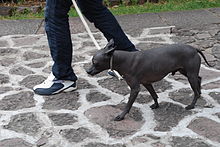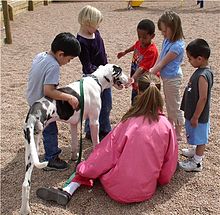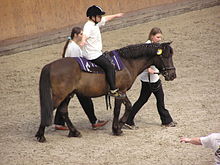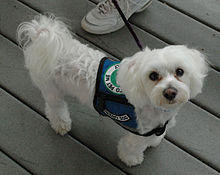- Animal-assisted therapy
-
Animal-assisted therapy (AAT) is a relatively new field of study, although the human-animal bond has existed for thousands of years. AAT is a type of therapy that involves animals as a form of treatment. The goal of AAT is to improve a patient’s social, emotional, or cognitive functioning. Animals can also be useful for educational and motivational effectiveness for participants [1] .
Animals are tools for therapy because they can make people feel safe and loved when they have been deprived of social interaction or hurt by other people. They do not communicate with words, and so patients afraid of approaching people can comfortably approach an animal. Additionally, a therapist who brings along a pet is viewed as being less dangerous by the patient, and so the previously uncommunicative patient is willing to share more with the professional [2]. Animals commonly used for therapy include dogs, cats, horses, birds, rabbits, and other small animals.
 Dogs are common in animal-assisted therapy.
Dogs are common in animal-assisted therapy.
Contents
History
Early Relationships
 St. Roch is often depicted with a dog.
St. Roch is often depicted with a dog. The Mexican Hairless Dog was a favorite among the Aztecs.
The Mexican Hairless Dog was a favorite among the Aztecs.
The Aztecs believed that dogs were sent by the god Xolotl to be spiritual guides in life. A breed they favored particularly was the Xolo, now commonly known as the Mexican Hairless Dog. Clay figures of these dogs date back to 300-900 AD in the Aztec culture. The Aztecs believed they provided magical power to alleviate pain in the joints and stomach, and draped the dogs over the painful area for relief. [3].
St. Roch, the patron saint of dogs, was born in 1295 the son of a wealthy governor in Montpellier, France [3]. When he was just 20 years old his parents died, leaving him with an immense fortune. He distributed his inheritance to the poor and lived his life as a pilgrim, passing on the role of governor to his uncle. When a plague struck the city, his prayers seemed to have special healing powers for the public, and so he travelled from city to city as a public healer. This continued until he contracted the illness himself, and to avoid spreading it to more people he hid in the woods to live out his days. Later, a dog found him and returned with a loaf of bread every day. The dog also licked the sores on his legs caused by the plague, slowly nursing him back to health. Today we know that dogs’ saliva actually has a small amount of antibiotic which may have been instrumental in his healing process.
The dog’s owner Lord Gothard eventually found him and took him in, and St. Roch survived the whole ordeal. Today, no one is sure what specific breed of dog saved his life, but he is always depicted in artwork with a dog at his side.[3]
Pets and Socialization
Towards the end of the 17th century in Europe, the tradition of owning pets began to extend out from the wealthy upper class to the urban middle class. Populations were moving to more rural areas and began owning more animals. As the beginning of a socialization trend in animals, John Locke advised giving children pets so that they could learn to be gentle and have responsibility for others. Other 18th-century reformers believed pets could teach children to control their own wild behaviors by controlling real animals. It has even been reflected in children’s literature during this time period and stories were written about animal welfare to promote kindness and placid behavior in youth. Today, pets can be introduced to school settings for young children.[4] .
Pets and Mental Health
The earliest reported case of AAT for the mentally ill took place at the York Retreat in England, led by William Tuke in the late 18th century [4]. Patients at this facility were allowed to wander the courtyards and gardens that were full of small domestic animals, proven to be effective tools for socialization. In 1860, the Bethlem Hospital in England followed the same trend and added animals to the ward, greatly influencing the morale of the patients living there [4].
Bethel, located in Bielfeld, West Germany, is a center for epileptic patients as well as other mental disorders. In 1867 they began implementing animals into their treatment plans. This tradition continues today, and patients care for dogs, cats, horses, birds, and farm animals [2].
The first documented case of AAT in the United States was in the military. From 1944-45, the Army Air Force Convalescent Center in Pawling, New York used dogs, horses, and other farm animals to rehabilitate airmen [2]. After the war the program ended and no records exist today to tell of its successes.
The first documented child psychologist to use companion animals as a diagnostic and therapeutic technique was Boris Levinson, an American [2]. In the 1970’s he wrote reports of its effectiveness, but his colleagues dismissed it as a useless concept. Still though, Levinson was able to prove in a questionnaire of over four hundred psychotherapists that over one third of them had used animals in their practice at some point and 58 percent had recommended pets for their patients. More than half of the therapists believed children’s adjustment problems like depression, anxiety, phobias, and schizophrenia could be treated with the help of an animal. So although Levinson was publicly ridiculed for his research in AAT, he was uncovering a growing trend in this society [2].
Later in the same decade, Dr. Samuel and Elizabeth Corson reviewed AAT in an institutional setting [2]. Working with patients that had already failed to respond to any other form of treatment, the researchers provided each individual with their own dog or cat for the duration of the study. It was important to pair the patient with an animal that had a similar personality; the dogs were classified as either “aggressively friendly”, “shy-type friendly”, or “withdrawn, extremely shy”. In the sessions that followed, the patients were much more open with the therapist, answering questions more thoroughly. Subjectively, the patients seemed to be happier overall, and only 3 of the 50 patients failed to respond to this treatment [2].
Pets and Stress
The therapeutic effects of human-animal relationships can be related to changes in physical health as well. An initial study conducted by Friedmann et al. (1980) on coronary heart disease patients suggested that pet owners lived longer than people who did not own pets. They believed this occurred for several reasons. First, owning an animal demands a lot of work and a regular routine. This sense of responsibility can be beneficial for individuals who are retired and do not have any kind of scheduled activity for the day. Second, pets can provide full love and attention unconditionally, unlike humans that often bring negative emotions to a relationship. Humans also demand speech in interactions, while communication with pets can often occur without a spoken word. Finally, maintaining one’s attention on a fish or an animal playing can have a relaxing effect in the same way as holding attention in mediation. Overall, there is a sense of companionship and stress-relief in pet ownership. The results from this research and the theories it provided then provided the basis for several other studies to follow [5] .
In 1988, a study conducted by Julia K. Vormbrock and John M. Grossberg reviewed the physiological effects of petting and talking to dogs. The patients were first selected for positive or neutral opinions of dogs. The researchers discovered that blood pressure was lowest while petting the dogs, slightly higher when talking to the dogs, and highest when speaking with the experimenter. This reduction in blood pressure is important news for individuals with hypertension, and this simple alternative to medicine could be helpful for patients [6] .
Modern Animal-Assisted Therapy
Animals can be used in a variety of settings – prisons, nursing homes, mental institutions and hospitals, in the home, and in society. They are always analyzed for internal and external parasites before therapy can begin [2].
Prisons
Pets are given to prisoners to elicit affectionate care from violent individuals. In 1975 at the Lima State Hospital for the Criminally Insane, social worker David Lee presented the inmates with small animals like fish, birds, and gerbils [2]. The inmates were so appreciative of the new creatures that Lee was able to establish a reward system where people could work towards owning one of their own pets. Overall, the inmates did not change so drastically as to suggest they could be sent back into society, but the number of fights did reduce significantly and suicide attempts nearly ceased altogether. Even with their history of violence against humans, they were able to have warm relationships with the pets provided. The relationship between staff and inmates improved as well and positive communication was established [2].
Nursing Homes
For the elderly, the companionship of owning a pet can be valuable, especially if they do not have any family or friends nearby to visit. The pet loves them in an unconditional way that supports their idea of identity; they can, in effect, make someone feel young and worthwhile again. They also provide an opportunity for fun and relaxation [2].
Mental Institutions and Hospitals
The conditions of mental institutions have improved over the years, but patients can still have anxiety when they are hospitalized. Dr. Barker and Dr. Dawson (1998) performed a study on the use of AAT in reducing anxiety levels of institutionalized patients. They determined that anxiety levels were significantly reduced in patients with mood disorders and psychotic disorders after a session of AAT. In fact, for the patients with psychotic disorders, those who participated in AAT had twice the reduction in anxiety scores as those who participated in some other form of recreational activity. This suggests the low demands of human-animal interaction was effective for individuals with psychotic disorders as compared to traditional therapy [7] .
The National Capital Therapy Dogs Inc. at the National Institute of Health (NIH) has more than fifty teams of pet/human therapist combinations that work with patients that have severe medical conditions. They are able to improve morale for people who are undergoing intense medical treatments, reducing depression and anxiety as well as chronic pain. Walking with the dogs can improve circulation as well, especially for patients who spend most of their day in bed. Advocates for this kind of therapy are optimistic about how the NIH is incorporating animals into their programs, as this field has the potential to have a huge beneficial impact on the hospitalized population [8] .
Home and Society
It is estimated that 54 million Americans are disabled, representing 20% of the population [8]. Assistance dogs for the blind and deaf are very effective, serving essentially as simple prosthetic devices. They are capable of doing a various chores around the home, and help the individuals navigate in the real world. Additionally, people who own assistance dogs often feel more comfortable in public than those who use canes. Strangers are often a bit wary of their vulnerability when they are carrying a cane, but the dog acts as a symbol of strength and control for the handicapped and can create a bond between animal-lovers [2].
Some other physical disabilities may include cerebral palsy, epilepsy or seizures, multiple sclerosis, Parkinson’s disease, or spinal cord injuries [8]. The pets provide primarily a physical service for these individuals, although of course the aspect of companionship exists as well. Other disabilities may be psychological, like agoraphobia, panic attacks, posttraumatic stress disorder, or manic depression [8]. In the case of agoraphobia, a traditional tool in therapy is to recruit a “safe person” to leave the house with each day. This, however, can be problematic because these individuals also have lives of their own and so they are not available all hours of the day. Using “safe pets” instead ensures a constant availability, and the individual can feel comfort knowing that they did not inconvenience anyone in the process [8].
Animals can also be aware of internal states, and so they can alert individuals of an impending epileptic seizure, diabetic seizure, or a manic episode. They can also go find help when their owner is in the midst of a seizure or episode, and dogs have even been trained with specialized phones to dial 911. Also if the owner has children the dog can be trained to keep the children at a safe distance until it is over [8].
Researchers believe dogs have the ability to sense impending epileptic seizures because of electrical changes that occur in the brain, in the same way dogs can predict an oncoming thunderstorm [8]. The more dominant viewpoint is that a dog’s extraordinary sense of smell can pick up on sweating or other secretions that occur just before the seizure. Diabetic seizures are easier for the dogs to detect because when blood sugar levels drop, a diabetic’s breath will change from sweet to a sharp ammonia scent. This ability to smell chemical changes is unsurprising when the statistics are taken into account: dogs have an estimated 20 to 40 times more smell sensory receptors than humans and can detect odors with 10 million times more sensitivity [8].
Equine therapy
Hippotherapy can be an effective treatment for people with physical or mental challenges.
Hippotherapy is the use of horses in therapy. Hippos is the Greek word for horses, and this type of therapy has been effective in treating people with a wide spectrum of problems: physical, behavioral, social, cognitive, and psychological. Patients may have cerebral palsy, Down’s syndrome, multiple sclerosis, depression, mental retardation, or spina bifida. Hippotherapy has also been approved by the American Speech and Hearing Association as a treatment method for individuals with speech disorders [8].
The concept of therapeutic horseback riding has existed for over a century but really became popular after Liz Harwell won the Silver Medal in dressage at the 1952 Helsinki Olympics.[8] This victory was particularly impressive because she was nearly paralyzed from the waist down from polio. Elsbeth Bodthker, a Norwegian physical therapist, was inspired by Harwell and established riding groups for disabled children.
Today, hippotherapy programs exist in at least 24 countries. [8] A distinction exists between hippotherapy and therapeutic riding. The North American Riding for the Handicapped Association defines hippotherapy as horse-based physical therapy provided by a licensed professional, while therapeutic riding uses similar techniques to improve muscle control, strength, and social skills, though they lack the professional therapist. It is important to note that the goal of both is to integrate body and spirit for the patients in order to improve their condition.[8] In addition, equine assisted psychotherapy (EAP) uses horses for work with persons who have mental health issues. EAP often does not involve riding.
The Delta Society
"In an age of research when it is tempting to reduce human emotions to biochemical reactions and to rely heavily on the technology of medicine, it is refreshing to find that a person’s health may be improved prescribing contact with other living things. Members of the health and allied professions must continue to combine resources, work together in the spirit of cooperation, and never forget to ‘cure when possible but comfort always.’"
—Michael J. McCulloch, MD (1981)
The Delta Society is a non-profit organization that specializes in AAT, currently located in Bellevue, WA [9] . They provide therapy, companion, and service animals for those in need, promoting happier, healthier lives. It was established in the 1970’s by veterinarians Dr. Leo K. Bustad, Dr. R. K. Anderson, Dr. Stanley L. Diesch, Dr. Joe Quigly, and Dr. Alton Hopkins, and psychiatrists (as well as brothers) Dr. Michael J. McCulloch, and Dr. William McCulloch. They all believed that pets had a positive impact on people’s health and overall happiness because of that they had observed in their own lives. They could not, however, begin any drastic changes in therapy until more scientific research was done in the field. As more research on the reduction of blood pressure, stress, and anxiety was released in regards to animal-human relationships, the Delta Society had the scientific evidence to put their theory in practice.
Since then the group has successfully founded Pet Partners – the first standardized training program for AAT, educating both the animals and the handlers [9]. They promote the idea that “both ends of the leash” should be qualified for this kind of therapy. Those who have been certified for therapy visit hospitals, nursing homes, schools, and rehabilitation centers to have a positive effect on the inhabitants that reside there. Pet Partner teams were first certified in 1990 once they passed a set of skill and behavior standards.
The Delta Society has also distinguished between Animal Assisted Activities (AAA) and Animal Assisted Therapy (AAT) [9]. In AAA, the pet is presented to the patient for the general purpose of socialization and morale improvement. In AAT, specific therapeutic goals are set forth; for example, a patient might work on range of motion in physical therapy by playing fetch with a dog. Service animals and therapy animals have also been classified by the Delta Society. Service animals are those that are trained to help people with disabilities perform everyday tasks. On the other hand, therapy animals are introduced to people so that they can experience the therapeutic effects of interacting with them.
Disaster Relief
The Federal Emergency Management Agency (FEMA) first began using dogs as part of their relief efforts in 2004 when Buddy the Golden Retriever visited Florida after Hurricane Charlie. Dogs used in the Canine Disaster Relief help to relieve the anxiety many victims of natural disasters feel, and bring them hope for their future. Acting as "psychological first aid" they are able to ease emotional stress when families interact with them [10]. Dogs have also been used after the attack on 9/11, Hurricane Katrina and the Oklahoma City Bombing. [11]
References
- ^ "About Animal Assisted Therapy". American Humane Association. http://www.americanhumane.org/interaction/programs/animal-assisted-therapy/about/.
- ^ a b c d e f g h i j k l Beck, Alan (1983). Between Pets and People: the Importance of Animal Companionship.. New York: Putnam. ISBN 0399127755.
- ^ a b c Sakson, Sharon (2007). Paws & Effect. New York: Alyson Books. ISBN 1593500386.
- ^ a b c Serpell, James (2000). "Animal Companions and Human Well-Being: An Historical Exploration of the Value of Human-Animal Relationships.". Handbook on Animal-Assisted Therapy: Theoretical Foundations and Guidelines for Practice: 3–17.
- ^ Friedmann, Erika; Katcher, Lynch, Thomas (1980). "Animal Companions and One Year Survival of Patients After Discharge From a Coronary Care Unit.". Public Health Reports 4 (95): 307–312.
- ^ Vormbrock, Julia; Grossman (1988). "Cardiovascular Effects of Human-pet Dog Interactions.". Journal of Behavioral Medicine 11 (5): 509–517. doi:10.1007/BF00844843. PMID 3236382.
- ^ Barker, Sandra; Dawson (June 1998). "The Effects of Animal-Assisted Therapy on Anxiety Ratings of Hospitalized Psychiatric Patients". Psychiatric Services 49 (6): 797–801.
- ^ a b c d e f g h i j k l Becker, Marty (2002). The Healing Power of Pets: Harnessing the Amazing Ability of Pets to Make and Keep People Happy and Healthy.. New York: Hyperion. ISBN 0786868082.
- ^ a b c "Delta Society - The Human-Animal Health Connection". The Delta Society. http://www.deltasociety.org/.
- ^ FEMA: "Buddy," A Disaster Relief Dog, Visiting The Northern Panhandle
- ^ "Disaster Stress Relief". Therapy Dogs International. http://www.tdi-dog.org/OurPrograms.aspx?Page=DSR+%28Disaster+Stress+Relief%29.
Further reading
- Barker, S.; Dawson, K. (1998). "The effects of animal-assisted therapy on the anxiety ratings of hospitalized psychiatric patients". Psychiatric Services 49: 797–801.
- Howie, Ann R., (2000). The Human-Animal Health Connection Pet Partners Team Training Course Manual 5th Ed. Delta Society, Renton, WA.
- Howie, Ann R., (2000, 2006). "Starting a Visiting-Animal Group" Providence St. Peter Foundation, Olympia, WA.
- Learning More, (2006). Aqua Thought Foundation. Retrieved April 9, 2006.
- Oakley, Dawn., and Bardin, Gail., The Potential Benefits of Animal Assisted Therapy for Children With Special Needs. Retrieved April 9, 2006.
External links
- Assistance Dogs International
- Rebecca Skloot, "Creature Comforts", New York Times, December 31, 2008
- Equine Guided Education Association
- Delta Society - The Human-Animal Health Connection
- HOPE Animal-Assisted Crisis Response - "Comfort in times of crises"
- Reading Education Assistance Dogs (R.E.A.D.)
- Animal Therapy.net - Animal-Assisted Therapy
- Holistic Online - Pet Therapy
- Elephant Therapy
- Equine Assisted Psychotherapy - "Equine Assisted Growth and Learning Association"
- Therapy Dogs United, Inc., promotes the animal-to-human bond through animal-assisted therapy
- Canine Assisted Therapy, Inc.
See also
- Care farming
Categories:- Environmental psychology
- Human–animal interaction
- Outdoor education
- Therapy
Wikimedia Foundation. 2010.






